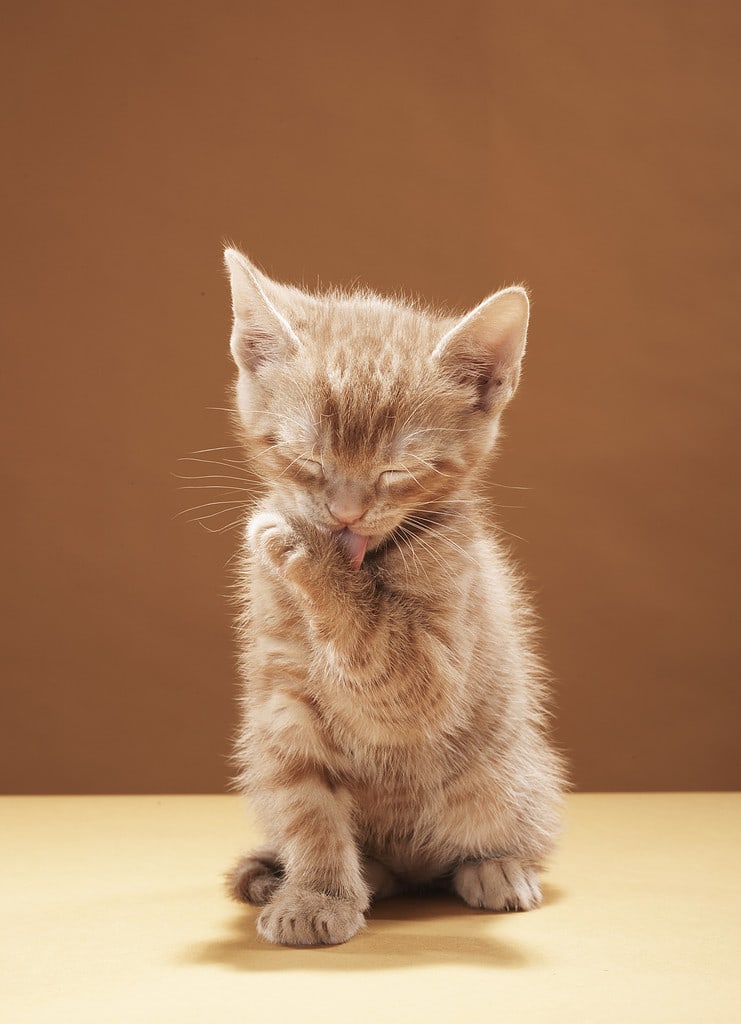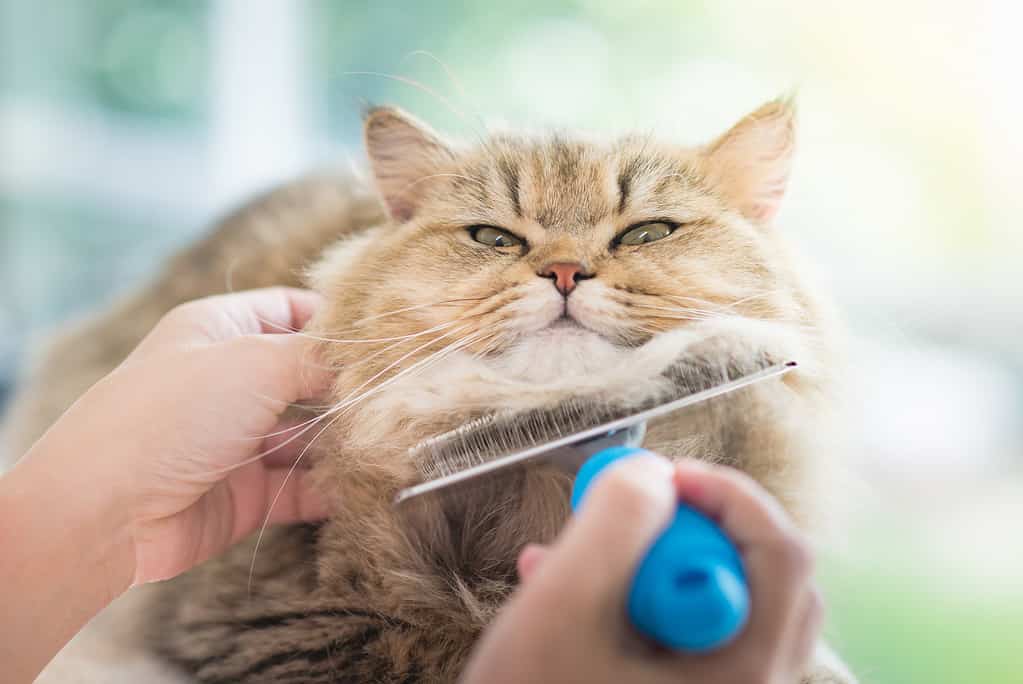
Domestic cats will spend nearly 50% of their day grooming their coat.
©NiseriN/iStock via Getty Images
Cats are incredible animals that are self-sufficient and can handle themselves in a domestic house or out in the wild. They are hunters at birth and are intelligent enough to solve problems to get what they want. One of the best attributes of cats is how they like to be clean. Their habits of burying their feces and constantly grooming themselves indicate they love a healthy coat free of dirt.
But how do cats actually clean themselves? It seems improbable that simply licking themselves is enough to remove dirt and dust from their coat. Are their tongues designed in a specific way for cleaning? Is there a special enzyme in their saliva that breaks down dirt? What is the secret to how cats clean themselves?
How Often Do Cats Groom Themselves?
Cats are creatures of habit, spending the majority of their day napping and cleaning themselves while nibbling on food and drinking water. Every cat has their own ritual of how they groom themselves regarding where they start, stop, what spots to clean first, and what spots to clean most often.
According to the animal behaviorist Pamela Perry of Cornell University, cats spend 30 to 50 percent of their day grooming their coats.
How Do Cats Groom Themselves?

Long-haired cats like Maine coons spend more time grooming than short-haired cats.
©Bogdan Kurylo/iStock via Getty Images
Animals naturally lick their bodies as a way of cleaning themselves. Dogs lick their paws or small cuts to wipe away blood, birds molt and shed feathers, and snakes shed their skin to heal or allow room for growth. Cats love staying clean, and they groom themselves on a regular basis. They incorporate several biological advantages to accomplish this goal.
Evolutionary Tongues
A cat’s tongue is so coarse that it feels like sandpaper. Microscopic viewing highlights that a cat’s tongue does not have the same taste buds as those of humans and dogs. Instead, they have tiny hook-like spines called papillae. These spines are made of keratin, the same material as human hair and fingernails.
Cats use the papillae on their tongues to brush their coat with such fine detail that it breaks up knotted hair while stimulating skin glands to produce sebum (natural body oil). The tongue spreads the oil across the body, helping to remove old hair, dust, dirt, and parasite eggs. Because cats are highly flexible, they can lick the majority of their body, including their chest, legs, back, tail, and behind.
However, the cat will be ingesting some dirt in the process, which their bodies can handle thanks to their strong stomach acids which break down small amounts of dirt and dust on the coat. When too much hair, dirt, and dust lump together, a cat will cough it out as a hairball. Otherwise, it is passed through the digestive system.
Wiping with Paws
Cats use their paws to help them reach areas of their body they cannot directly lick such as their head and neck.
To clean these areas, cats lick their paws. Then, they rub their paw over their face to remove old food or dust from their whiskers or brush dirt off of their head and neck. They re-lick their paws every few swipes to help loosen dirt, so it comes off more easily.
Nail Trimming
Cats need to scratch on several rough surfaces to keep their nails sharp. Scratching rough surfaces causes the nails to splinter, allowing for new nails to grow while discarding the old sheath. Cats lick and chew their paws to remove dirt and keep their nails trimmed.
Domestic cats have a harder time naturally keeping their back nails short unless there are large scratching posts that a cat can climb up and dig their nails into. Otherwise, cats chew them to allow new nails to grow.
Why Do Cats Groom Themselves

Kittens have a lot of energy that gets vented out by grooming and playing with littermates.
©Martin Poole/DigitalVision via Getty Images
Grooming is a natural habit for cats. Kittens learn to groom themselves by watching how their mothers groom them and their littermates. However, grooming serves a variety of purposes.
Cats clean themselves to:
- Stay Clean: Cats love being clean and groom themselves to remove knots, dirt, dust, and old food from their coat and whiskers. Grooming helps remove dead hair and whiskers to allow new, healthier hair to emerge.
- Regulate Body Temperature: Cats cannot sweat like humans, nor can they pant like dogs. If a cat is panting, then it means something is seriously wrong and they should be taken to an emergency room immediately. Cats lick themselves to help stay cool on warm days.
- Stimulate Circulation of Skin: As mentioned before, cats use the spines on their tongue to stimulate skin glands to produce oil. The oil is spread across the body, giving cats a healthy and shining coat. It also makes the skin soft and smooth, allowing them to move more quickly when playing or hunting.
- Emotionally Sooth: Cats are creatures of habit and routine. They can be easily stressed by simple things like furniture changing, vacuum cleaners, multiple moving bodies, or new people in the house. Grooming releases endorphins to keep cats calm and relaxed. Some veterinarians believe grooming reminds them of being with their mother, which puts them at ease.
- Hide Scent from Prey: Cats are expert hunters, and a key trick to being an expert hunter is hiding your scent from prey. By burying their feces, licking their coat to be free of dirt, and having a smooth coat to minimize resistance while running, cats can easily stalk and lunge at prey without being noticed.
Can Cats Overgroom Themselves?

Slicker brushes have thinner and stronger teeth than regular brushes to help prevent and unravel knots.
©anurakpong/iStock via Getty Images
Overgrooming is the habit where an animal is continuously grooming themselves to the point it becomes detrimental to their health and their skin becomes red or irritated.
Grooming is a relaxing and pleasurable experience for animals. Overgrooming means they are addicted to making themselves feel good at the cost of their health.
Signs of overgrooming are:
- Hair loss
- Red and irritated skin
- Constantly licking
- Hair feels dry or dull
- Minimizing other habits like eating, drinking, or resting
Why Do Animals Overgroom?
The most common reasons for an animal overgrooming themselves are:
- Allergies causing their skin to feel itchy
- Stress from changes in the household
- Boredom with having nothing to do
- Moving or experiencing a big change in the house or family
Can Owners Help Groom Their Cats?

It is recommended to introduce nail trimming to kittens, so they become familiar with the technique.
©frantic00/iStock via Getty Images
Owners should absolutely groom their cats. Cats are highly social animals. They thrive with healthy social engagement from littermates or their owners. They like to show affection and build stronger bonds.
Owners can help cats with their grooming habits by:
- Brushing Coat: Use a slicker brush to remove excess hair and dirt from their coat. Brushing their coat during seasonal changes reduces the chance of hairballs because the brush will remove the excess hair. It will also stimulate the skin glands to produce their natural oil, making their coat smooth and shiny. Brushing is essential for long-haired cats to detangle knots early.
- Clean House: Keep their environment clean by picking up loose hair, vacuuming the floors, and wiping dust to prevent it from sticking to the cat.
- No Baths: Do not bathe a cat unless they are used to being in the water and enjoy it. Cats do not need baths because they have a system to clean themselves. Chronic bathing will remove the oils on their coat, leaving their skin vulnerable to irritation or infections.
- Dental Care: Perform routine dental care to keep their mouth clean. Use a pet toothbrush and pet-safe toothpaste or gels to remove plaque and tartar from their teeth so any dirt that is trapped in their mouth does not cause gingivitis. Indoor cats have a higher chance of developing dental disease because owners overlook dental care.

A cat grooming their owner is a sign of trust and affection.
©Nils Jacobi/iStock via Getty Images
Cats are a unique species that flourish in clean environments. Keeping their coats clean tactically makes them better hunters and supports their overall health by removing knots and dirt. Owners should brush their cat’s coat daily to support their habits while nurturing a deep bond.
The photo featured at the top of this post is © Bogdan Kurylo/iStock via Getty Images
Thank you for reading! Have some feedback for us? Contact the AZ Animals editorial team.







